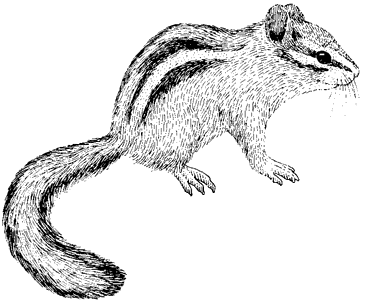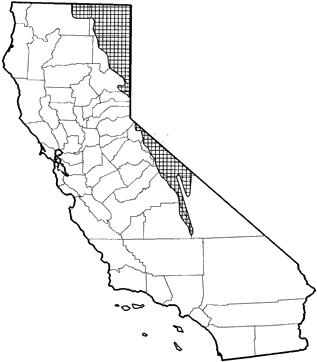
Least Chipmunk
Distribution, Abundance, and Seasonality
The least chipmunk is the most widespread North American chipmunk, both in geographic range and habitats. In California, this species is fairly common to common east of the Sierra Nevada crest in sagebrush, low sagebrush, bitterbrush, and other Great Basin shrub habitats. It is less common in the brushy understory of sparse to open canopies of other habitats, including Jeffrey pine and pinyon-juniper. In the White Mts., and a few localities in the Sierra Nevada and Cascades, this species also ranges into alpine dwarf-shrub habitats.

Range Map
Specific Habitat Requirements
Feeding: Feeds on seeds, nuts, fruits, berries, and insects. Fruits of bitterbrush are important in some areas (Grinnell and Storer 1924, Chappell 1978). Feeds on the ground, in shrubs, and in trees. Stores food in an underground cache for winter use.
Cover: Uses stumps, logs, rocks, and shrubs for cover when resting, grooming, or when alarmed.
Reproduction: Uses ground nests and nests under logs. Uses a "work hole" when digging burrows, then plugs the hole and uses a less conspicuous entrance (Woods 1980). Also uses tree nests (Genoways and Jones 1972, Broadbooks 1974). May move young to tree nest after they begin activity out of the nest (Broadbooks 1977).
Water: Does not require water source other than food, but will use such a source if available. Compared to other chipmunks, this species has a lower rate of water loss, greater tolerance for heat load, high relative medullary thickness of the kidney, and concentrated urine. These adaptations allow occupancy of arid sagebrush habitats, which is not possible for other chipmunks (Heller and Gates 1971, Heller and Poulson 1972, Jones and Wang 1976, Chappell et al. 1978).
Pattern: In the alpine zone, the presence of talus is important. In Great Basin shrub types, highest densities are encountered where bitterbrush is present. This species is competitively excluded by other chipmunks, therefore, the range of habitats occupied depends on the presence or absence of other chipmunk species.
Species Life History
Activity Patterns: Diurnal. Most activity occurs in early morning in hot sagebrush habitat (Chappell 1978). Facultative hibernator (Heller and Poulson 1970); active all months or hibernating from October to April. Males enter hibernation first.
Seasonal Movements / Migration: None.
Home Range: Reported home ranges vary. In Alberta (Sheppard 1972), males had an average home range of 1.22 ha (3.02 ac) varying from 0.39-3.45 ha (0.96 8.52 ac), females averaged 0.66 ha (1.62 ac) varying from 0.22-1.51 ha (0.48-3.32 ac). Martinsen (1968) reported home ranges from 0.2-1.5 ha (0.5-3.7 ac). Chappell (1978) reported that adult males wander more widely than females, and that about 50% of the young disperse from the natal area. Martinsen (1968) reported that females increase the size of their home range after dispersal of young, and that home range size is greater if food availablity is low.
Territory: This species shows a high degree of intraspecific aggression, and may have a rate of 6.16 encounters per hr with conspecifics (Chappell 1978). An exclusive territory is not maintained, except perhaps around the nest. The home ranges of females are more exclusive than those of males.
Reproduction: Mating occurs March through April, with gestation lasting 28-30 days. Average litter size about 6, with single litter per yr most common. A second litter is possible if the first is lost (Skryja 1974). Young are born April through May and appear above ground in June to early July.
Niche: Small, diurnal omnivore. Competitively inferior to other chipmunk species, showing ecological release if other species are absent or removed. The least chipmunk is excluded from pinyon-juniper woodlands or conifer forests by T. amoenus or T. speciosus (Sheppard 1971, Meredith 1977, Chappell 1978). Probably competitively inferior to T. panamintinus and T. umbrinus as well. Adapted for arid habitats, which other chipmunks cannot tolerate. Predators include raptors, weasels, coyotes, foxes, and bobcats.
Sources & References
California Department of Fish and Game, 1999.
California's Wildlife, Sacramento, CA.
Written by: J. Harris, reviewed by: H. Shellhammer, edited by: R. Duke
Brand, L. R. 1976. The Vocal Repertoire of Chipmunks (Genus Eutamias) in California. Anim. Behav. 24:319-335. Broadbooks, H. E. 1974. Tree nests of chipmunks with comments on associated behavior and ecology. J. Mammal. 55:630-649. Broadbooks, H. E. 1977. Tree nesting and maternal behavior of chipmunks. Southwest. Nat. 22:154-155. Chappell, M. A. 1978. Behavioral factors in the altitudinal zonation of chipmunks (Eutamias). Ecology 59:565-579. Chappell, M. A., A. V. Calvo, and H. C. Heller. 1978. Hypothalamic thermosensitivity and adaptations for heat-storage behavior in three species of chipmunks (Eutamias) from different thermal environments. J. Comp. Physiol. 125:175-183. Criddle, S. 1943. The little northern chipmunk in southern Manitoba. Can. Field-Nat. 57:81-86. Forbes, R. B. 1966a. Fall accumulation of fat in chipmunks. J. Mammal. 47:715-716. Forbes, R. B. 1966b. Notes on a litter of least chipmunks. J. Mammal. 47:159-161. Genoways, H. H., and J. K. Jones. 1972. Mammals from southwestern North Dakota. Occas. Pap. Mus. Texas Tech. Univ. 6:1-36. Grinnell, J., and T. I. Storer. 1924. Animal Life in the Yosemite. Univ. California Press, Berkeley. 752pp. Hall, E. R. 1946. Mammals of Nevada. Univ. California Press, Berkeley. 710pp. Heller, H. C. 1971. Altitudinal Zonation of Chipmunks (Eutamias): Interspecific Aggression. Ecology 52:312-319. Heller, H. C., and D. M. Gates. 1971. Altitudinal Zonation of Chipmunks (Eutamias): Energy Budgets. Ecology 52:424-433. Heller, H. C., and T. L. Poulson. 1970. Circadian Rhythms-II. Endogenous and Exogenous Factors Controlling Reproduction and Hibernation in Chipmunks (Eutamias) and Ground Squirrels (Spermophilus). Comp. Biochem. Physiol. 33:357-383. Heller, H. C., and T. L. Poulson. 1972. Altitudinal Zonation of Chipmunks (Eutamias): Adaptations to Aridity and High Temperature. Am. Midl. Nat. 87:296-313. Hock, R. J. 1963. Mammals of the White Mountain range, California. Univ. Calif. White Mt. Res. Sta. 5pp. Johnson, D. H. 1943. Systematic Review of the Chipmunks (genus Eutamias) of California. Univ. Calif. Publ. Zool. 48:63-143. Jones, D. L., and L. C-H. Wang. 1976. Metabolic and cardiovascular adaptations in the western chipmunks, genus Eutamias. J. Comp. Physiol. 105:219-231. Martinsen, D. L. 1968. Temporal patterns in the home range of chipmunks (Eutamias). J. Mammal. 49:83-91. Meredith, D. H. 1977. Interspecific agonism in two parapatric species of chipmunks (Eutamias). Ecology 58:423-430. Sheppard, D. 1971 Competition Between Two Chipmunk Species (Eutamias). Ecology 52:320-329. Sheppard, D. 1972. Home Ranges of Chipmunks (Eutamias) in Alberta. J. Mammal. 53:379-380. Skryja, D. D. 1974. Reproductive biology of least chipmunks (Eutamias minimus operarius) in southeastern Wyoming. J. Mammal. 55:2221-224. Vaughan, T. A. 1974. Resource allocation in some sympatric, subalpine rodents. J. Mammal. 55:764-795. Willens, N. J., and K. B. Armitage. 1975. Thermoregulation and water requirements in semiarid and montane populations of least chipmunks (Eutamias minimus). Comp. Biochem. Physiol. 51:717-722. Woods, S. E. 1980. The squirrels of Canada. Natl. Mus. Can., Ottawa. 199pp.
California Animal Facts | California's Wildlife